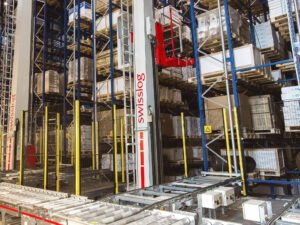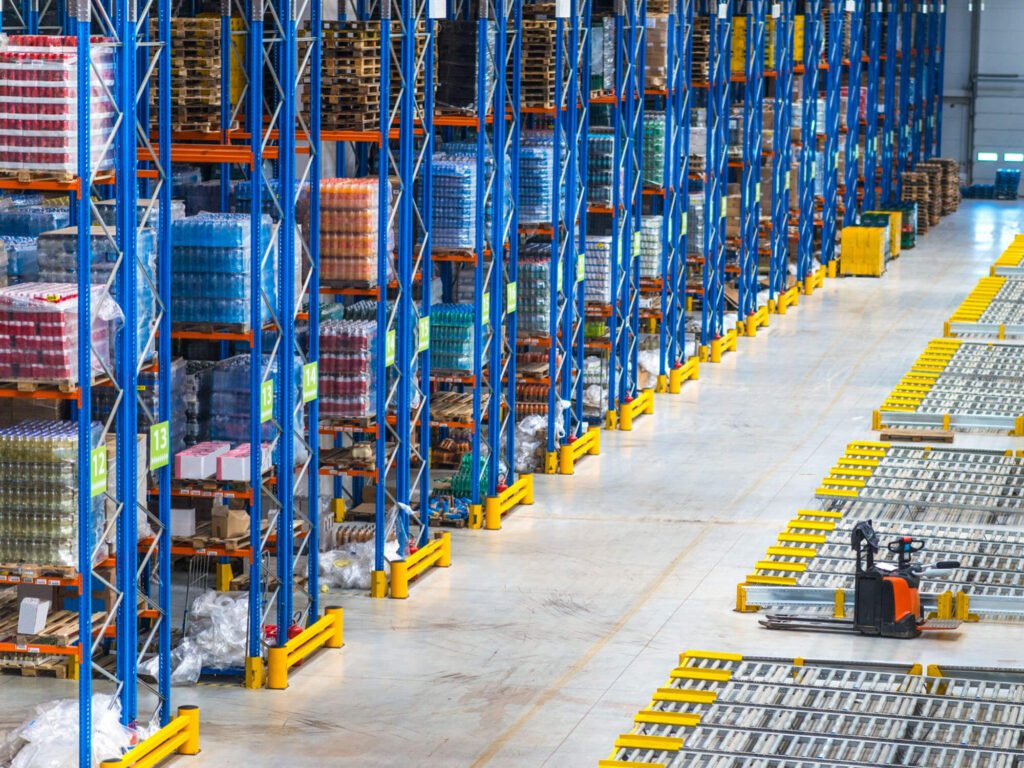An under-optimized warehouse will result in high operating costs and plummeting profits. That explains why warehouse space optimization has become an indispensable task for all organizations.
One of the most straightforward strategies to do that is to select suitable pallet racking types for the warehouse. So, you may ask, how many racking types are there on the market, and how can one know which type to use in which situation?
Well, this article will answer all those questions by introducing the most common pallet racking types, outlining their features, as well as the best circumstances to use them. Without further ado, let’s dive right in!
Pallet Racking 101: What Exactly Is This System?
Firstly, let’s find out what pallet racking is. Also known as pallet racks or pallet shelves, these terms refer to a warehouse tool that holds multiple loaded pallets, with one stacking on top of another, in many rows.
Originally invented in the 1920s to facilitate the storage and transportation of products, pallet racking is a brilliant solution that unlocks warehouses’ vertical space, and thus, maximizes storage capacity.
Over the course of a century, pallet racking has undergone tremendous development, with the emergence of many racking types, depending on their manufacturing material and sizes.
Pallet Racking’s Valuable Benefits
It is safe to say that pallet racking is a breakthrough invention of the logistics industry, thanks to its various wonderful benefits. Below are some of the most valuable advantages gained from using pallet racking:
- Utilizing the warehouse’s vertical space to maximize inventory capacity.
- Reducing both loading and unloading durations.
- Increasing warehouse safety as pallet racking designs can be compatible with other warehouse equipment like forklifts.
- Driving more revenues and lowering costs, thanks to the better storage capacity and easier stock handling.
Top 12 Pallet Racking Types To Optimize Your Warehouse Performance
Now, let’s get to the main reason why you are here, which is to learn about different types of pallet racking. Below are the 12 most common pallet racking types that you can install in your warehouse.
#1: Selective Pallet Racking (Single Deep Pallet Racking)
Selective pallet racking is by far the most common type out there. Also called “single deep pallet racking”, this racking type allows its users to access (or select) any particular pallet load without the need to move other pallets.
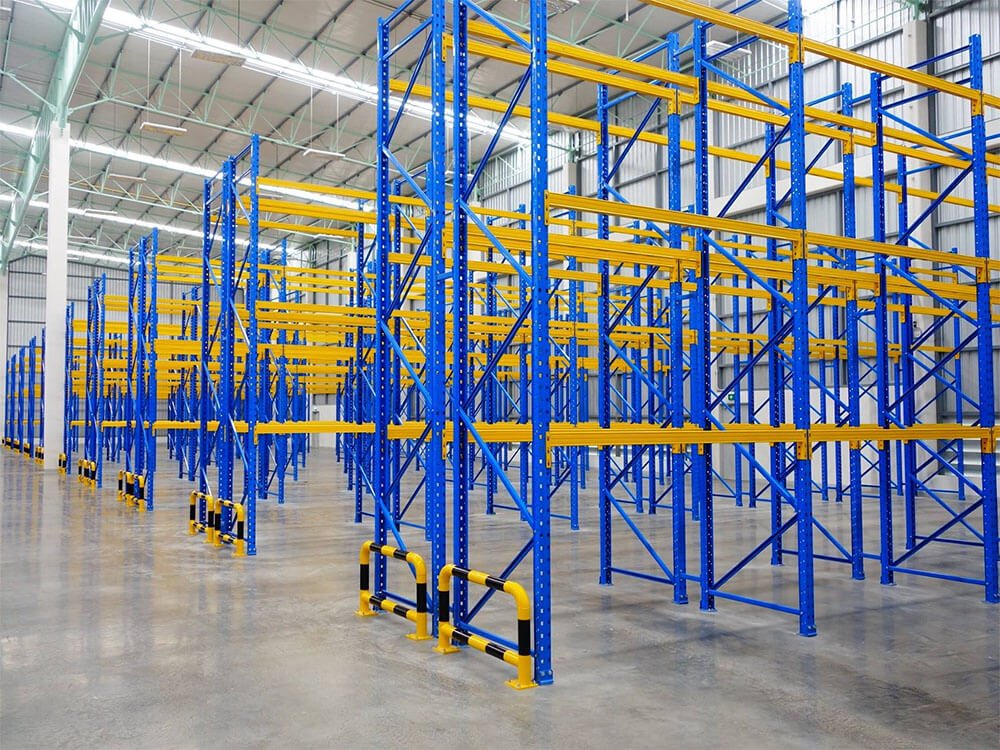
Besides the high pallet visibility, selective racking is also compatible with almost any forklift type, meaning no specialized lift trucks are required. And despite being the cheapest option out there, it occupies the most areas, and thus, has the lowest capacity.
If you are employing a “first in, first out” (FIFO) storage system, having various different products, or requiring to pick up pallets at lower levels, you should seriously consider selective pallet racking. It is an ideal option in those aforementioned cases.
PROS:
- Being the cheapest and most popular type in the market
- Providing direct access to every pallet in the warehouse
- Compatible with most forklifts
- High flexibility in width, height, and beam size selection
CONS:
- Taking up large spaces
- Requiring large aisles (3.0m – 4.5m) for easier maneuvers
IDEAL FOR:
- Warehouses with a FIFO inventory system or high product differentiation
- Suitable for industries like fashion and apparel, pharmaceuticals, and food and beverage
#2: Double Deep Pallet Racking
Alternatively referred to as “double reach racking”, double deep pallet racking is a variant of selective racking in which two rows deep are installed next to each other and utilized for storage purposes.
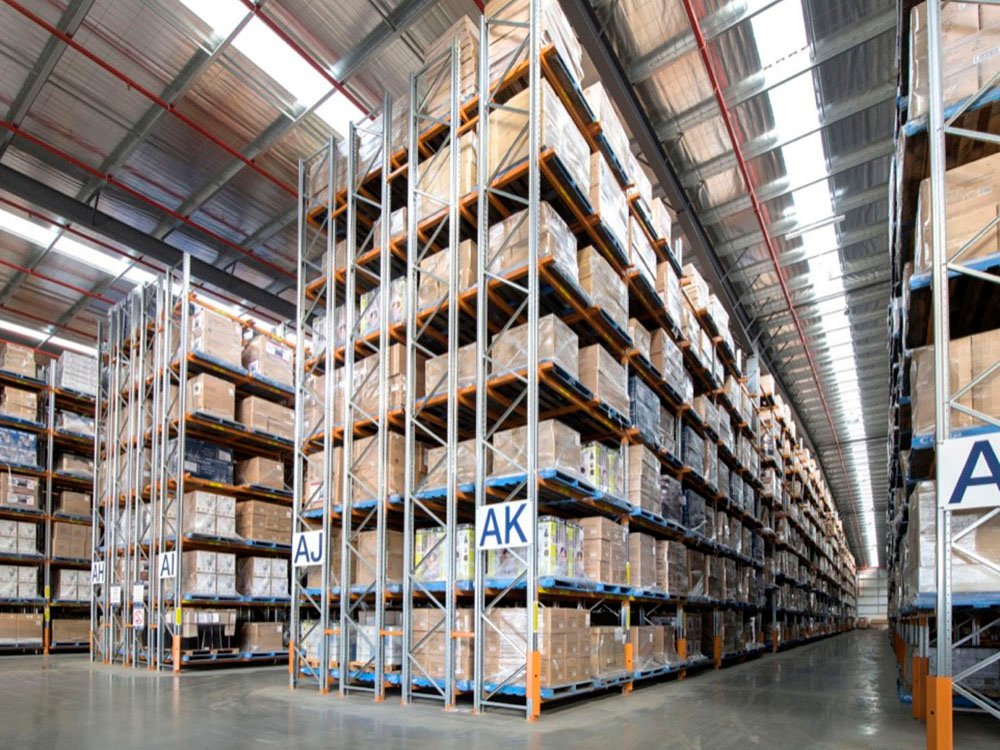
This new configuration helps augment warehouse capacity and effectively reduces the area occupied by aisles. Compared to other intricate racking systems, double deep pallet racking is more cost-effective.
However, its suitability is limited to “last in, first out” (LIFO) storage systems and uses involving multiples of the same product. Another drawback is the absence of direct access to all pallet loads.
PROS:
- Lower price than most complex racking types
- Increasing inventory density thanks to the double-deep design
- Offering flexible configurations
CONS:
- Lowering pick selectivity by half
- Limited to “last in, first out” (LIFO) systems only
- Demanding more costly handling trucks or forklifts
IDEAL FOR:
- Warehouses that store a large number of identical items on a pallet
- Suitable for industries like general manufacturing and food and beverage
#3: Push-Back Pallet Racking
Pallets on push-back racking are placed on inclined rails with at least three low-friction carts. This configuration is perfect for the “last in, first out” (LIFO) storage system and allows up to 6 pallets deep on both sides of the aisle.
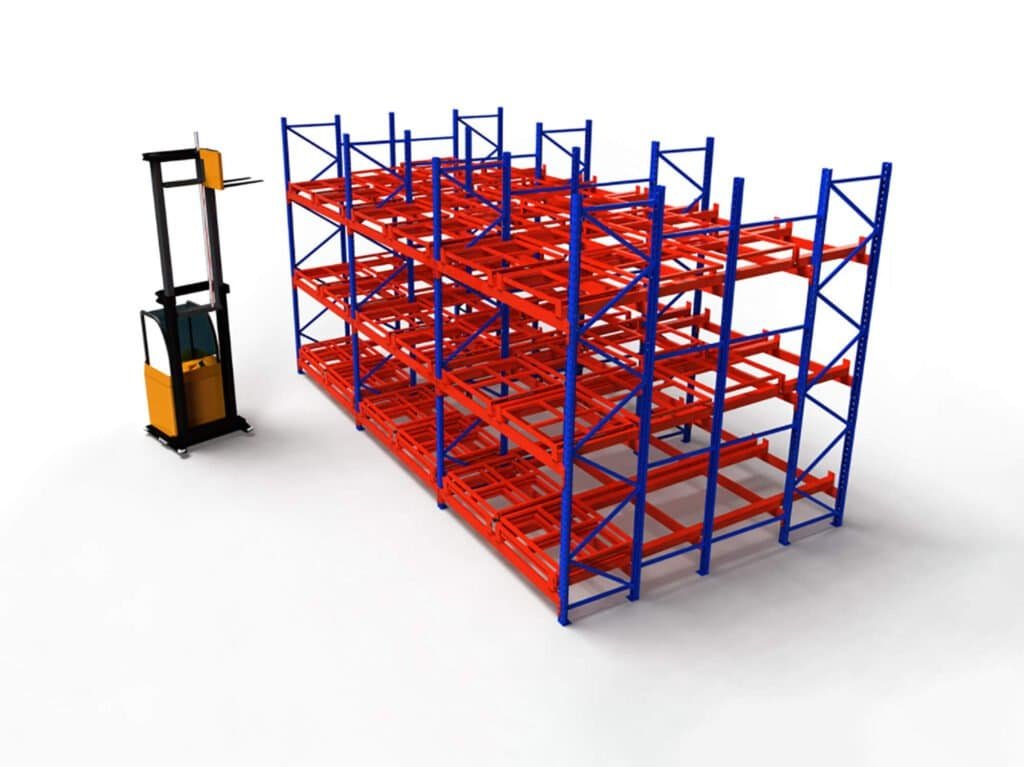
During the loading procedure, the newly loaded pallet will occupy the front position and push all subsequent pallets toward the back area of the rack. While unloading the front pallet, the entire row of remaining pallets will roll forward.
If you often store a large quantity of identical stock-keeping units (SKUs), let’s consider employing push-back pallet racking to maximize your storage capacity.
PROS:
- Large storage density
- Minimizing damages as forklifts have very limited access to the inner space of the rack
- Expanding up to 6 pallets deep
- Reducing time for picking products
CONS:
- Losing some vertical areas due to the inclined rails
- Requiring more maintenance with the carts, wheels, and bearings
IDEAL FOR:
- Warehouses with a high volume of identical SKUs on a single rail
- Suitable for industries like retail and general warehousing
#4: Pallet Flow Racking
Also known as gravity flow racking, this high-density racking system uses beds of rollers with centrifugal brakes to store pallets. This setup will have pallets loaded on one side and retrieved on the other side of the rack.
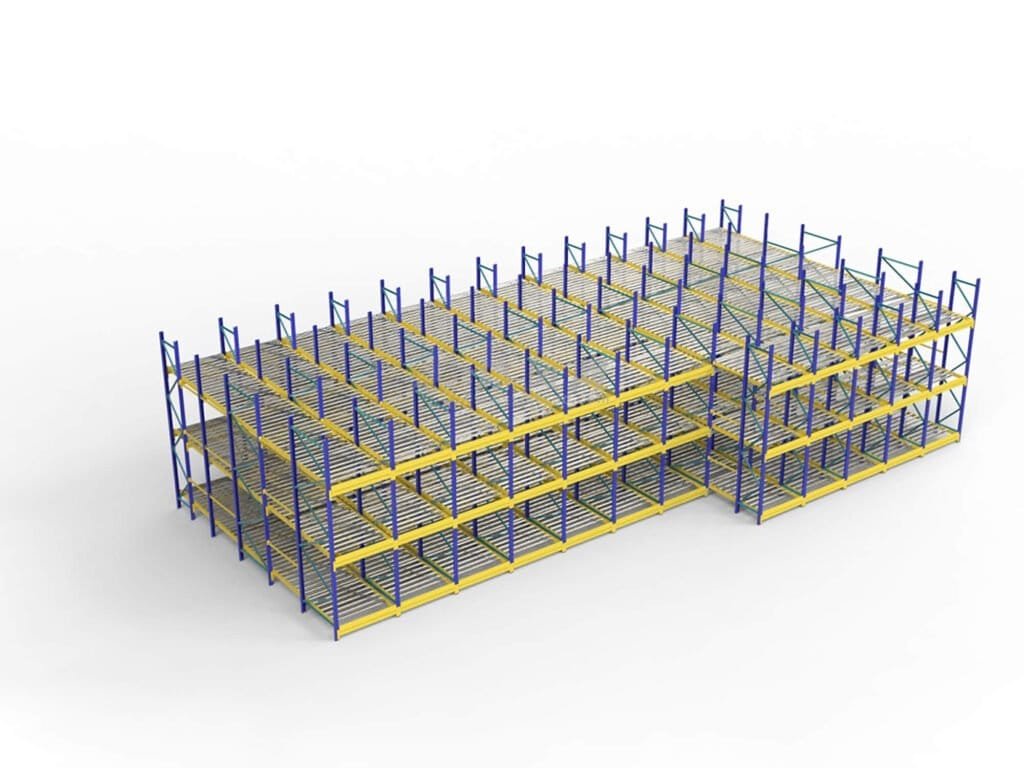
Although similar to push-back racking, this system still has several unique traits. One of them is that it is built for FIFO storage as the loading and unloading points are separate (unlike push-back racking, which is ideal for the LIFO system).
Pallet flow racking can accommodate extremely high-density storage, with the capacity reaching up to 20 pallets deep in a single lane. By reducing the number of aisles, this approach ensures optimal stock turnover.
PROS:
- Extremely high storage density
- Better warehouse space utilization, thanks to the lower demand for aisles
- Enhancing the loading and picking procedures
CONS:
- Quite expensive for installation
- Demanding higher-quality pallets and maintenance efforts
IDEAL FOR:
- Warehouses with a large volume of fast-moving SKUs
- Ideal industries include grocery and food distribution centers
#5: Drive-In Pallet Racking
Drive-in pallet racking is characterized by a single aisle that facilitates both the entry and departure of forklifts that come to pick up the goods. This high-density storage system employs side arms rather than cross beams to enable forklifts to access the storage system and handle pallets across all levels.
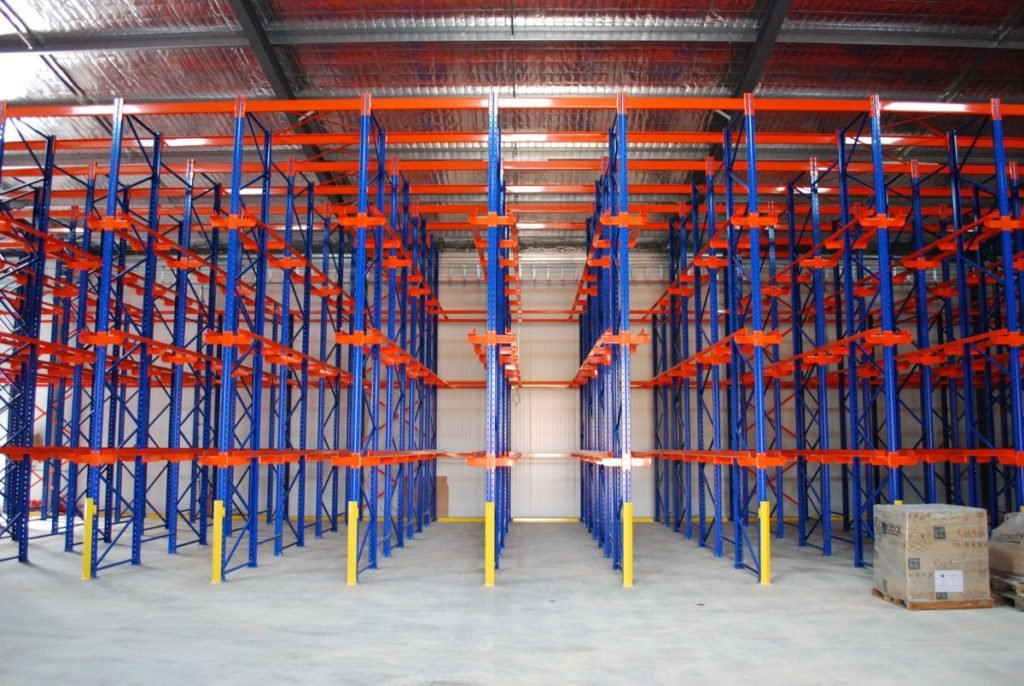
It functions optimally in “last in, first out” (LIFO) processes, in which the initial pallet available for removal is the last pallet loaded. Since this racking type removes almost all aisles, it works perfectly for warehouses storing high volumes of identical items in limited space.
PROS:
- Maximize inventory space due to the removal of most aisles
- Requiring limited warehouse areas
- Having full control over the entry and exit points
CONS:
- Posing greater damage risk as forklifts and racking can collide more frequently
- Quite expensive, compared to basic racking types
- Needing considerable handling due to the low selectivity
IDEAL FOR:
- Warehouses with “last in, first out” (LIFO) storage systems, having low product turnover, or storing non-perishable goods, or items with no expiry date
#6: Drive-Thru Pallet Racking
Many people often consider drive-thru pallet racking as an alias for drive-in racking systems, while these terms refer to two different storage configurations and thus cannot be used interchangeably.
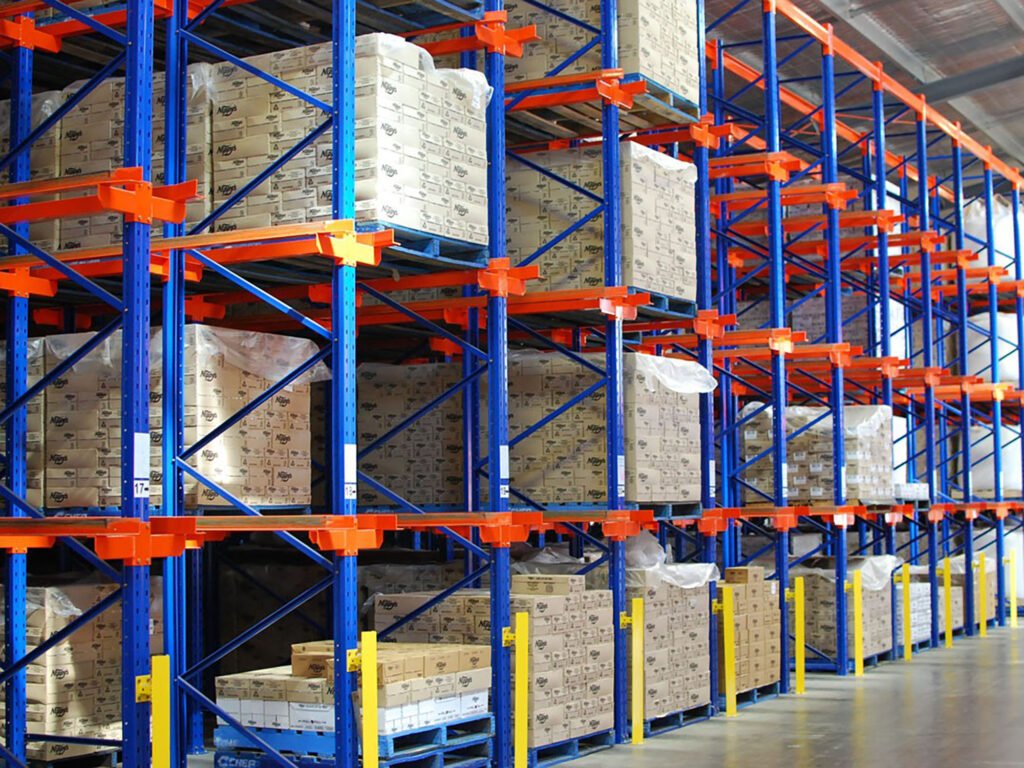
While drive-in racking is suitable for the LIFO approach as it uses a single aisle for both loading and unloading procedures, drive-thru pallet racking works best with the FIFO system by employing separate lanes for those two tasks.
While drive-thru racking provides optimal inventory turnover, it requires more storage space. Thus, you won’t be able to install drive-thru racking against your warehouse wall, like how you would do with drive-in types.
PROS:
- Perfect for FIFO storage systems
- Saving energy as forklifts don’t need to drive deep into the rack for loading and unloading products
- Reducing loading and retrieving time
CONS:
- Requiring more storage space for installation
- Higher chances of forklifts and racking being damaged
IDEAL FOR:
- Warehouses with high stock turnover
- Suitable industries include beverages, chemicals, and general warehousing
#7: Automated Storage And Retrieval System (AS/RS)
AS/RS, the warehouse whiz handles the heavy lifting of sorting, storing, and fetching products on demand. It’s not just about real-time inventory checks; it’s like a space-saving genius for both the floor and up high.

Back in the day, AS/RS seemed like a high roller, only for the big-budget players. But now, it’s the people’s choice,budget-friendly and finding its groove in many warehouses.
You’ve got a mix of AS/RS options, but the go-to is the Unit-Load AS/RS – think pallets, narrow aisle racks, and a crane.
PROS:
- Working its magic on both floor and vertical spaces
- Kissing manual labor goodbye for a safer warehouse
- Supercharging storage capacity and nailing order accuracy
- Keeping inventory in check like a seasoned pro
CONS:
- Coming with a bit of a price tag for installation
- Calling for a crew of skilled folks to run the show
IDEAL FOR:
- Warehouses with repetitive and predictable demands for their products
#8: Multi-Tier Pallet Racking
Multi-tier pallet racking is an ideal solution for leveraging your warehouse’s vertical space without sacrificing direct access to all the items therein. This manual system consists of multiple levels and walkways connected by stairs.
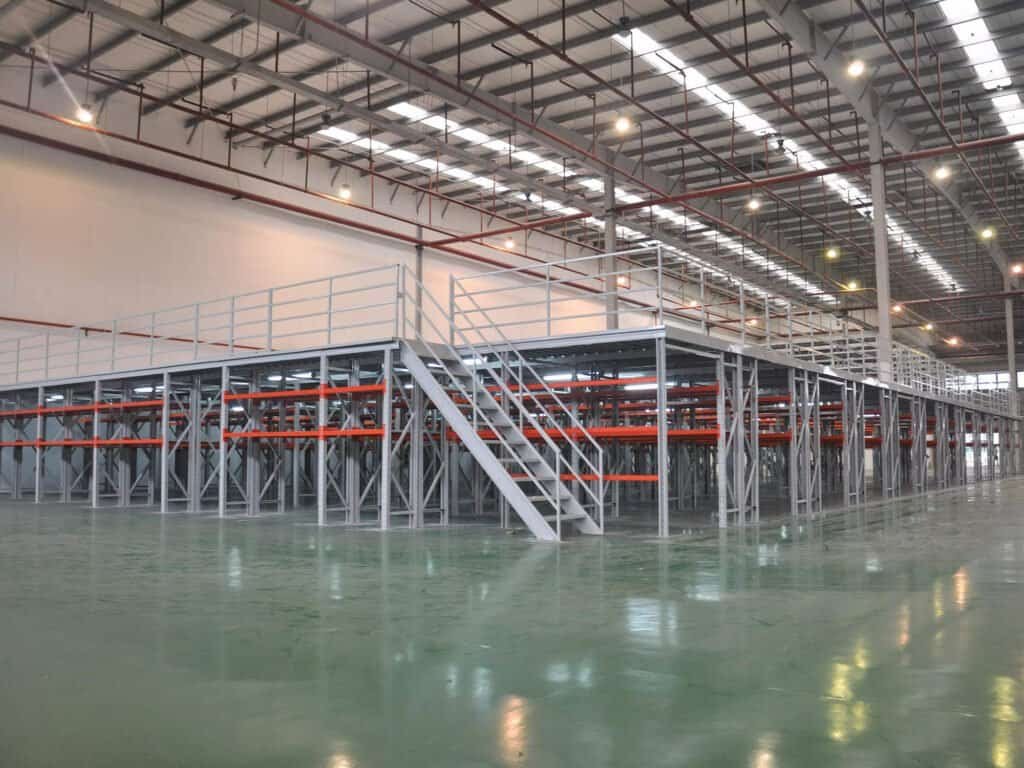
That structure enables your employees to access all items directly, both manually (by stairs) and automatically (by forklifts). You will often see this rack type in warehouses with limited floor space but storing a huge amount of small items, like auto parts or medicines.
Here is another cool thing about multi-tier pallet racking. Besides building it directly from the floor, you can also install it atop a mezzanine structure. With the latter setup, you can employ a distinct storage type below your multi-tier racks.
PROS:
- Best utilizing the warehouse’s vertical space
- Direct access to all SKUs, even manually
- Facilitating a safer working environment for staff
CON:
- Relatively expensive
IDEAL FOR:
- Warehouses that store many small items
- Suitable for industries like automobiles and pharmaceutical companies
#9: Narrow Aisle Pallet Racking
As the name suggests, vna pallet racking variant boosts your storage capacity by minimizing the floor space required for installation. You only need clear aisles of about 2 meters for this racking setup, which is tremendously space-saving.
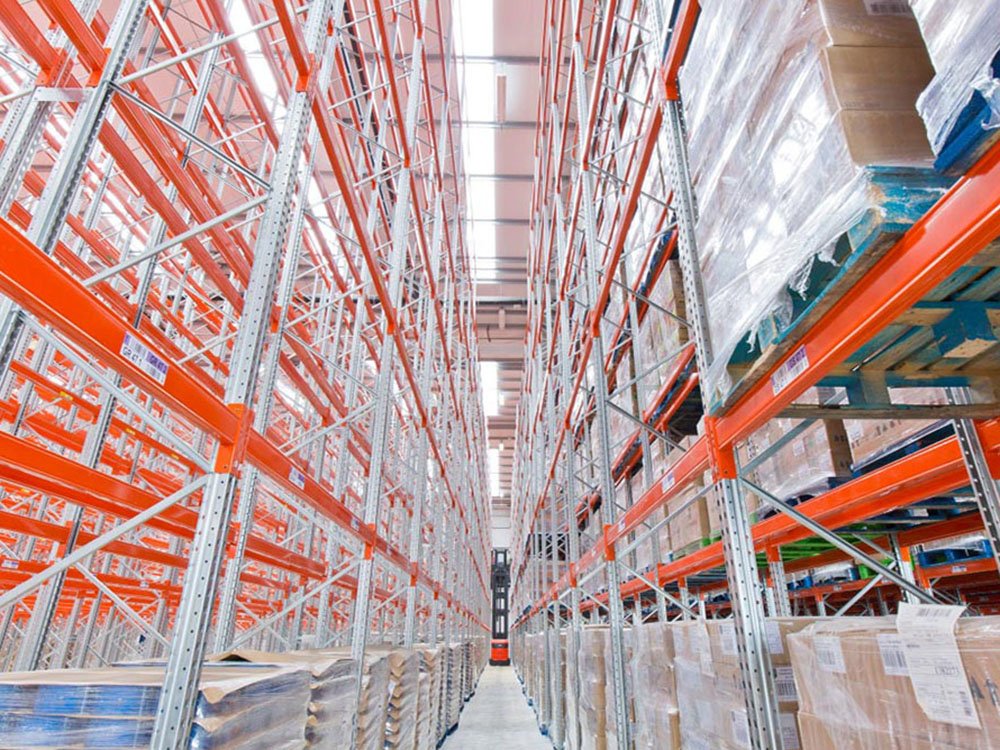
In addition to the narrow aisles, this storage system also provides great flexibility with height-adjustable beams to account for different types of goods. It is also an affordable option for many warehouses.
However, it surely comes with some disadvantages. One of them is the need for special forklifts to operate in the narrow aisles. Another drawback is that only one forklift can operate in a single lane at a time.
PROS:
- Highly affordable
- Minimizing aisles’ width to increase warehouse space utilization
- Providing great flexibility and selectivity
- Hand-picking possible on lower racks
CONS:
- Requiring special forklifts to maneuver in narrow lanes
- Only one forklift can operate at a time
IDEAL FOR:
- Warehouses with many fast-moving items, each of which is in small quantity
- Suitable for the furniture industry
#10: Mobile Pallet Racking
What sets the mobile pallet racking system apart from other types is its moving racking modules. In this configuration, chassis rails are installed on the floor to facilitate the side-to-side displacement of the racking blocks.
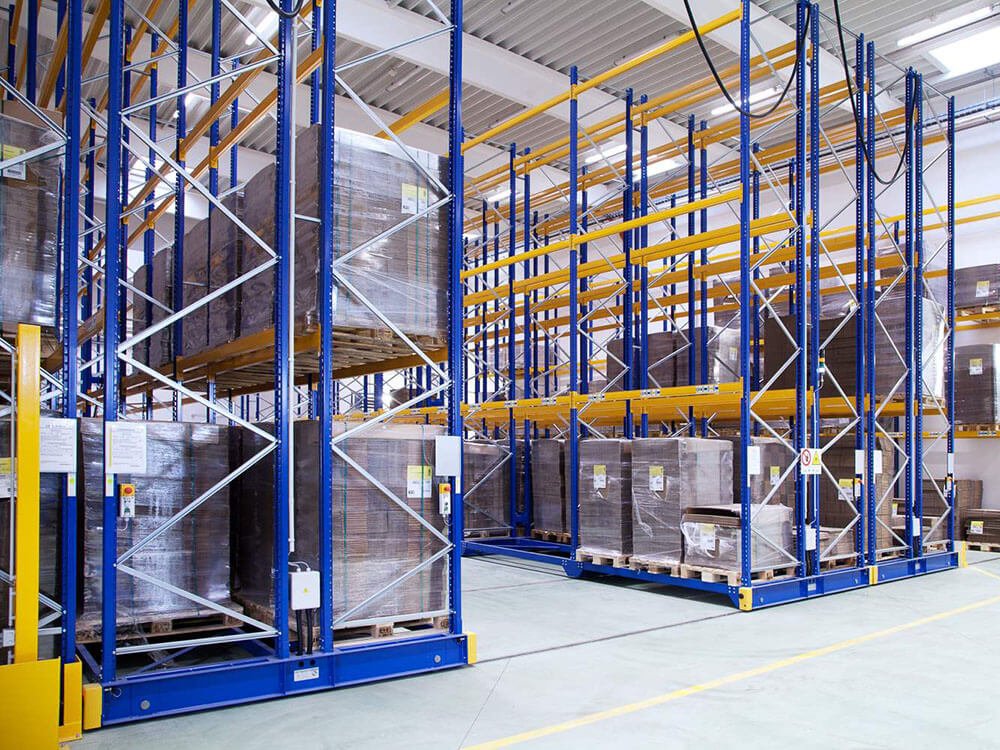
These movements will open up the aisles for forklifts’ operations. For example, let’s say you have three racking modules, namely block A, block B, and block C. If you want to pick up items from block A, simply slide block B over to reveal the space for your forklifts to go in and do the job.
When there is no need to load and unload goods, you can compact all the racking blocks together. This can provide extra space for your staff to move around, especially if you are combining mobile pallet racking with other racking systems nearby.
PROS:
- Saving warehouse space by collapsing aisles when not in use
- Maintaining high selectivity for small warehouses
- Still utilizing the vertical space
CONS:
- Needing more maintenance efforts with the chassis rails
- Quite costly
IDEAL FOR:
- Small warehouses with high building costs and demanding high storage capacity, such as cold storage facilities
#11: Radio Shuttle Pallet Racking
Unlike mobile pallet racking, where the racking modules move, shuttle racks comprise a remotely controlled pallet shuttles to assist in moving the pallets to either end of the racking. This helps save tons of time and manpower when handling items.
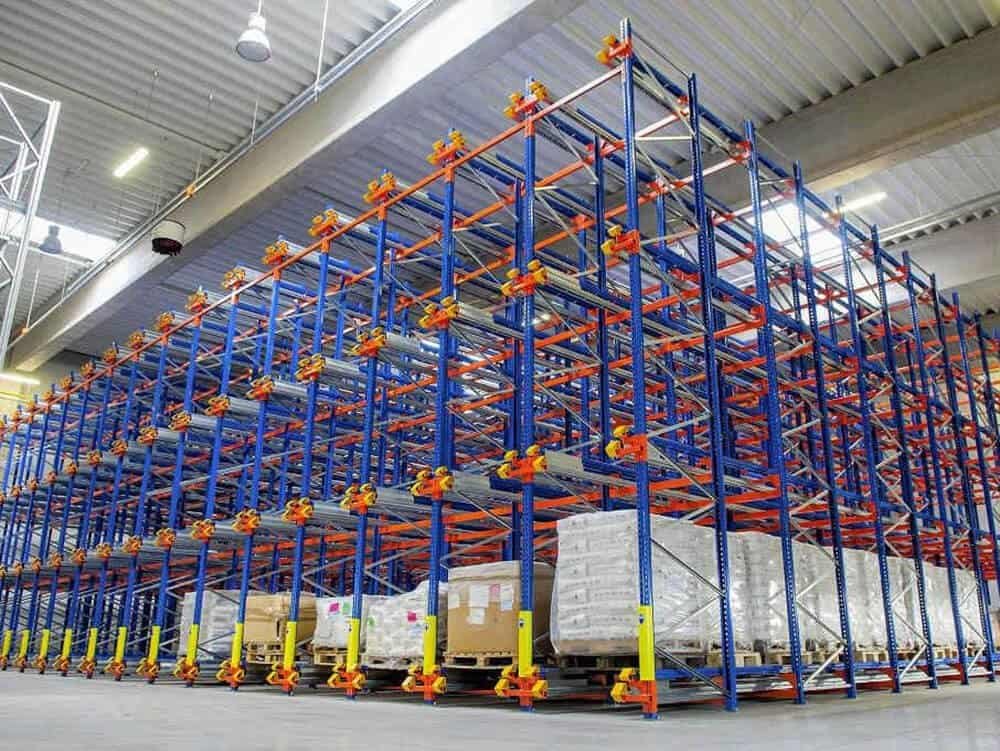
This storage setup is suitable for both FIFO and LIFO arrangements. That explains why shuttle pallet racking is a great alternative to drive-in and drive-thru racking types. You can even install up to 40 pallets per lane to optimize your warehouse capacity.
One drawback of shuttle pallet racking is its high cost. While the racks are affordable, the modern shuttle is quite expensive. Some models can cost up to 50,000 USD.
PROS:
- Providing high storage capacity, thanks to the use of pallet shuttles
- Allowing for up to 40 pallets deep
- Ideal for both FIFO and LIFO configurations
- A better option than drive-in and drive-thru racking types
CON:
- Demanding a high investment cost for the pallet shuttles
IDEAL FOR:
- Warehouses with many fast-moving items, with one SKU on a single lane
- Suitable for cold storage facilities
#12: High Rise Pallet Racking
Like multi-tier pallet racking, high-rise racks also aim at utilizing your storage facility’s height via the installation of multiple high racks. Some setups even span up to 30 meters high to make full use of your warehouse’s vertical areas.
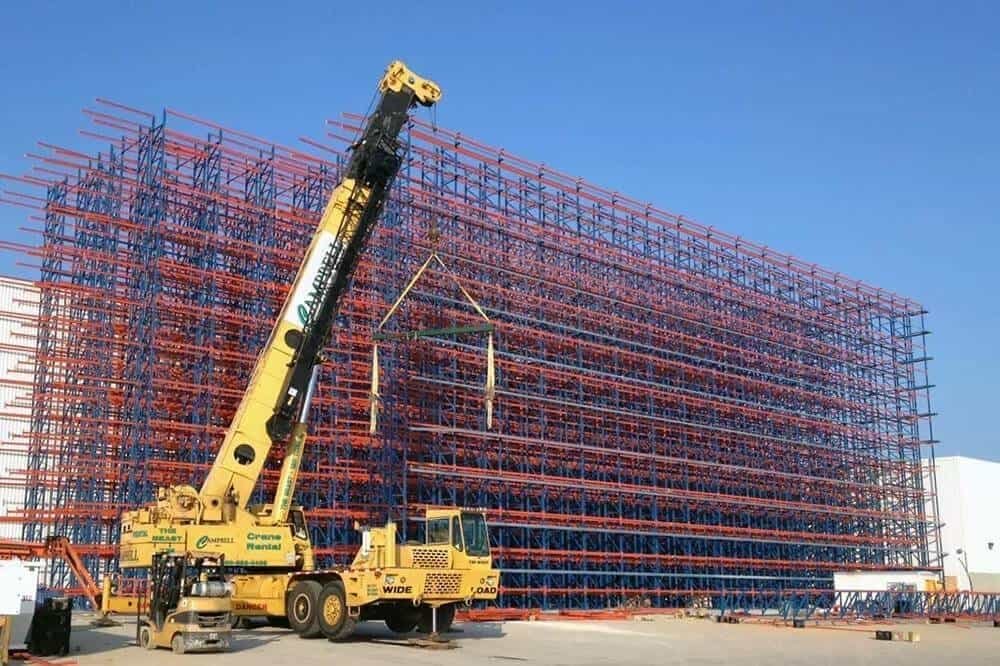
Of course, in order to achieve such heights, this racking type must come with many built-in safety functions, like anti-collapse features, reinforced steel beams, and safety barriers. Your warehouse will also need permits to operate these racks.
Instead of forklifts, many choose automated cranes to service high rise pallet racking. These machines automate the movement of pallets and obviate the necessity for manual labor. Thus, this system facilitates enhanced productivity and precision.
PROS:
- Optimizing your warehouse’s vertical space
- Enhancing productivity and accuracy via the operations of automated cranes
- Eliminating the need for manual handling
CONS:
- Incurring high costs for many safety functions
- Requiring permits
IDEAL FOR:
- Small warehouses with exceptionally high volumes of palletized products
Other Pallet Racking Types
Obviously, the number of pallet racking types does not stop at 12. There are many more specialized variants out there, and depending on your needs and your product’s features, you can pick the most suitable type for your business.
Here are some other racking types you can consider: carpet racking, cable racking, coil racking, tire racking, sheet racking, A-frame racking, oil drum storage racking, etc.
Summary
To wrap it up, there’s a whole bunch of choices when it comes to picking pallet racking styles. Opting for the right kind of system is a smart move to make the most out of your warehouse space and boost your profits.
This article dives into the nitty-gritty details of the 12 most common types of pallet racking you’ll come across, along with what makes each of them unique. Plus, it breaks down why having the right racks in your inventory brings essential benefits.


